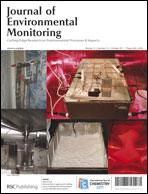Environmental monitoring data for planning, implementing and evaluating the Total Maximum Daily Loads (TMDL) management system have been measured at about 8-day intervals in a number of rivers in Korea since 2004. In the present study, water quality parameters such as Suspended Solids (SS), Biochemical Oxygen Demand (BOD), Dissolved Oxygen (DO), Total Nitrogen (TN), and Total Phosphorus (TP) and the corresponding runoff were collected from six stations in the Yeongsan River basin for six years and transformed into monthly mean values. With the primary objective to understand spatiotemporal characteristics of the data, a methodologically systematic application of a Self-Organizing Map (SOM) was made. The SOM application classified the environmental monitoring data into nine clusters showing exclusively distinguishable patterns. Data frequency at each station on a monthly basis identified the spatiotemporal distribution for the first time in the study area. Consequently, the SOM application provided useful information that the sub-basin containing a metropolitan city is associated with deteriorating water quality and should be monitored and managed carefully during spring and summer for water quality improvement in the river basin.

You have access to this article
 Please wait while we load your content...
Something went wrong. Try again?
Please wait while we load your content...
Something went wrong. Try again?


 Please wait while we load your content...
Please wait while we load your content...